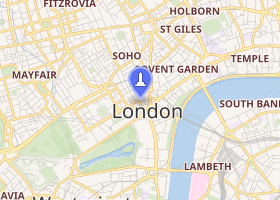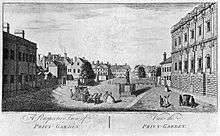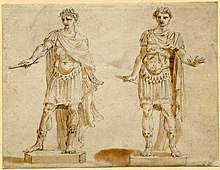Statue of James II, Trafalgar Square
The statue of James II is a bronze sculpture[2] located in the front garden of the National Gallery in Trafalgar Square, London, United Kingdom.[3] Probably inspired by French statues of the same period, it depicts James II of England as a Roman emperor, wearing Roman armour and a laurel wreath (traditionally awarded to a victorious Roman commander). It originally also depicted him holding a baton. It was produced by the workshop of Grinling Gibbons, and is most likely the work of the noted Brussels sculptor Peter van Dievoet[4] and Laurence Vandermeulen from Mechelen, rather than of Gibbons himself.[5] The statue has been relocated several times since it was first erected in the grounds of the old Palace of Whitehall in 1686, only two years before James II was deposed.
| Statue of James II | |
|---|---|
 The statue in 2015 | |

| |
| Artist | Peter Van Dievoet and Laurence Vandermeulen for the workshop of Grinling Gibbons |
| Year | 1686 |
| Type | Statue |
| Medium | Bronze |
| Movement | Classicism |
| Subject | King James II |
| Location | London, WC2 United Kingdom |
Listed Building – Grade I | |
| Official name | Statue of James II in front of National Gallery west wing |
| Designated | 5 February 1970 |
| Reference no. | 1217629[1] |
Description
The statue is executed in bronze and depicts James II as a Roman emperor. He is shown standing in a contrapposto pose and pointing downwards in "great ease of attitude and a certain serenity of air", as Allan Cunningham described it.[6] It formerly held a baton in its right hand, though this is now missing. The face is said to be an excellent depiction of the king.[7] Unusually for the time, the sculptor sought a degree of fidelity to original classical styles; James is depicted wearing a laurel wreath on top of short hair, whereas other imperial-style statues of both Charles II and James II depicted the two kings with an anachronistic combination of Roman armour and a 17th-century periwig.[8] The statue was probably inspired by similar imperial portrayals of Louis XIV of France. One in particular, a colossal statue by Martin Desjardins of the French king wearing Roman armour with a laurel wreath and baton, is so similar in type to the figures of Charles II and James II that it may have been their direct inspiration.[9]
The plinth is inscribed with the legend JACOBUS SECUNDUS/ DEI GRATIA/ ANGLIÆ SCOTIÆ/ FRANCIÆ ET/ HIBERNIÆ/ REX/ FIDEI DEFENSOR/ ANNO M.D.C.LXXXVI,[10] which translates to: "James II, by the grace of God, King of England, Scotland, France and Ireland. Defender of the Faith. 1686."[3]
History


The statue of James II is one of three of the Stuart monarchs commissioned by the royal servant Tobias Rustat from Grinling Gibbons's workshop in the 1670s and '80s, the others being of James's brother and predecessor Charles II: an equestrian statue in Windsor Castle and a standing figure at the Royal Hospital in Chelsea.[10] The statue of James II was commissioned for the Palace of Whitehall, apparently at the same time as the standing Charles II, and the two works might have been intended as pendant pieces.[10] It was produced in the workshop of Grinling Gibbons at a reported cost of £300 (equivalent to about £42,000 at 2014 prices).[13] Though the work was long attributed to Gibbons himself, large-scale sculptures were not his forte and it is probable that the statue's principal originators were Peter Van Dievoet and Laurence Vandermeulen.[5] The Dutch sculptor Artus Quellinus III (also known as Arnold Quellan), who was working at Gibbons's workshop at the time[14] is another possible contributor to the statue.

The James II was erected at the Palace of Whitehall on 24 March 1686, as recorded by a contemporary, Sir John Bramston the Younger.[10] George Vertue, who found an agreement and a receipt of payment for the work, wrote that it was "modelled & made by Lawrence Vandermeulen (of Brussels) [sic] ... & Devoot[5] [i.e. Peter Van Dievoet][15] (of Mechlin) [sic] who was imployed [sic] by ... Gibbons", and that Thomas Benniere was involved in the casting.[10] A series of five drawings in the British Museum, which might be for either the standing Charles II or the James II, is attributed variously to Gibbons or to Van Dievoet.[16] Its artistic qualities were praised by J. P. Malcolm in his 1803 history, London Redivivum, in which he wrote:
There is but one fault in the figure, and that is the attitude. The King seems to point with a baton at the earth, to which his eyes are directed; but why? Surely this is an egregious error. However, perhaps the artist may have been commanded to model the statue thus; and if not, his mistake is more than counter-balanced by the beautiful turns of the muscles, the excellence of the features, and the true folds of the drapery.[17]
James II's statue has stood in several locations since it was first erected.[18] It originally stood in the Palace of Whitehall's Pebble Court, where it was installed on New Year's Day, 1686. It was situated behind the Banqueting House and faced the river, a position which attracted much satirical comment after James' flight from London during the Glorious Revolution of 1688; it was said that the statue's location indicated his method of escape.[6]
It was taken down after the Glorious Revolution but was replaced by order of William III. In 1898 it was moved to a location in the garden of Gwydyr House, but was taken down four years later to make room for the stands for the coronation of Edward VII.[13] It lay on its back amid grass and weeds in a state of total neglect until it was re-erected in 1903 outside the New Admiralty building,[6] but was displaced again when the Admiralty Citadel was built in 1940. During the Second World War it was put into storage at Aldwych tube station.[10] It was relocated to its present site in 1947.[18] The statue is listed by Historic England as a Grade I listed building, a status which it was granted in 1970.[1]
.jpg) The statue when it stood on the grounds of the Privy Garden of the Palace of Whitehall. Engraving by N. Smith (1791)
The statue when it stood on the grounds of the Privy Garden of the Palace of Whitehall. Engraving by N. Smith (1791).jpg) Engraving of the statue of King James II by T. Lester (1816), without a baton.
Engraving of the statue of King James II by T. Lester (1816), without a baton. Engraving of the statue on the front of The Saturday Magazine, 1833
Engraving of the statue on the front of The Saturday Magazine, 1833
References
- Historic England. "Statue of James II in front of National Gallery west wing (1217629)". National Heritage List for England. Retrieved 9 July 2015.
- "Outside the Gallery". National Gallery, London. Retrieved 13 September 2014.
- "Statue: James II statue". LondonRemembers.com. Retrieved 13 September 2014.
- "Artistes, de père en fils". Site-LeVif-FR. 2008-11-21. Retrieved 2019-12-09.
- Other version : Horace Walpole, Anecdotes of painting in England: with some account of the principal artists; and incidental notes on other arts; collected by the late Mr. George Vertue ; and now digested and published from his original MSS. by Mr. Horace Walpole, London, 1765, vol. III, p. 91: "Gibbons had several disciples and workmen; Selden I have mentioned; Watson assisted chiefly at Chatsworth, where the boys and many of the ornaments in the chapel were executed by him. Dievot of Brussels, and Laurens of Mechlin were principal journeymen — Vertue says they modelled and cast the statue I have mentioned in the privy-garden". According to David Green, in Grinling Gibbons, his work as carver and statuary (London, 1964), one Smooke sayd to Vertue that this statue "was modelled and made by Laurence and Devoot (sic)" ; George Vertue, Note Books, ed. Walpole Society, Oxford, 1930–47, vol. I, p.82 : "Lawrence. Dyvoet. statuarys", and ibidem IV, 50 : "Laurens a statuary of Mechlin... Dievot a statuary of Brussels both these artists were in England and assisted Mr. Gibbons in statuary works in K. Charles 2d. and K. James 2d. time, they left England in the troubles of the Revolution and retird to their own country".
- Gleichen, Edward (1928). London's Open-Air Statuary. London: Longman, Greens & Co. pp. 47–8. OCLC 7498425.
- White, Paul William (1971). On Public View. London: Hutchinson. p. 39. ISBN 9780091090302.
- Ayres, Philip J. (1997). Classical Culture and the Idea of Rome in Eighteenth-century England. Cambridge University Press. p. 64. ISBN 9780521584906.
- Whinney, Margaret (1992). Sculpture in Britain, 1530–1830. Yale University Press. p. 121. ISBN 9780300053180.
- Ward-Jackson, Philip (2011), Public Sculpture of Historic Westminster: Volume 1, Public Sculpture of Britain, Liverpool: Liverpool University Press, pp. 291–3, ISBN 9781846316913CS1 maint: ref=harv (link)
- "drawing". British Museum. Retrieved 2019-12-29.
- Katherine Gibson, 'The emergence of Grinling Gibbons as a statuary', published in Apollo, September 1999, p .28.
- Borenius, Tancred (1926). Forty London Statues and Public Monuments. London: Methuen & Co. p. 46. OCLC 3042767.
- Chilvers (2009). The Oxford Dictionary of Art and Artists. Oxford University Press. p. 508. ISBN 9780199532940.
- Antoine-Nicolas Dézallier d'Argenville, de l'Académie Royale des Belles-Lettres de la Rochelle, Vie des fameux sculpteurs depuis la renaissance des arts, avec la description de leurs ouvrages, Paris, chez Debure l'aîné, 1787, tome II, pp. 101–102 : "On compte parmi ses (de Gibbons) élèves Wartson, Dievot de Bruxelles, et Laurent de Malines: leur nom est peu connu, ainsi que celui de leur maître. Ces artistes dignes d’une plus grande réputation, se retirèrent dans leur patrie, à l’époque de la révolution d’Angleterre".
- "Drawing". Collection online. British Museum. Retrieved 28 November 2014.
- Malcolm, James Peller (1803). Londinium Redivivum: Or, An Ancient History and Modern Description of London. 4. London: J. Nichols. p. 280. OCLC 5827713.
- Matthews, Peter (2012). London's Statues and Monuments. Oxford: Shire Publications. p. 14. ISBN 9780747807988.
Bibliography
- George Vertue and Horace Walpole, Anecdotes of painting in England, London, 1765, vol. III, p. 91.
- George Vertue, Note Books, ed. Walpole Society, Oxford, 1930–1947, vol. I, pp. 61, 82, 106 ; vol. IV, p. 50.
- Antoine-Nicolas Dézallier d'Argenville, de l'Académie Royale des Belles-Lettres de la Rochelle, Vie des fameux sculpteurs depuis la renaissance des arts, avec la description de leurs ouvrages, Paris, chez Debure l'aîné, 1787, tome II, pp. 101–102.
- Katherine Gibson, "The emergence of Grinling Gibbons as a statuary", published in Apollo, September 1999.
- Alain Van Dievoet, "Un disciple belge de Grinling Gibbons, le sculpteur Pierre van Dievoet (1661–1729) et son œuvre à Londres et Bruxelles", in: Le Folklore brabançon, March 1980, vol. 225, pp. 65–91 (with description and history).
- The James II Statue, UK Parliament
External links
| Wikimedia Commons has media related to Statue of James II in Trafalgar Square. |
- Statue of James II – Trafalgar Square, London, UK at Waymarking.com
